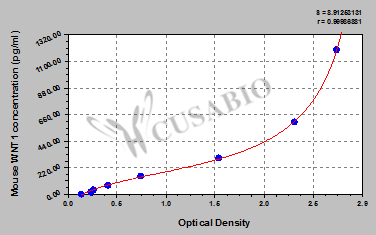| Code | CSB-EL026128MO |
| Size | 96T,5×96T,10×96T |
| Price | Request a Quote or Start an on-line Chat |
| Trial Size |
24T ELISA Kit Trial Size (Only USD$150/ kit) * The sample kit cost can be deducted from your subsequent orders of 96T full size kits of the same analyte at 1/5 per kit, until depleted in 6 months. Apply now |
| Intra-assay Precision (Precision within an assay): CV%<8% | ||||||
| Three samples of known concentration were tested twenty times on one plate to assess. | ||||||
| Inter-assay Precision (Precision between assays): CV%<10% | ||||||
| Three samples of known concentration were tested in twenty assays to assess. | ||||||
| To assess the linearity of the assay, samples were spiked with high concentrations of mouse WNT1 in various matrices and diluted with the Sample Diluent to produce samples with values within the dynamic range of the assay. | ||||||
| Sample | Serum(n=4) | |||||
| 1:1 | Average % | 90 | ||||
| Range % | 86-94 | |||||
| 1:2 | Average % | 84 | ||||
| Range % | 80-88 | |||||
| 1:4 | Average % | 89 | ||||
| Range % | 84-93 | |||||
| 1:8 | Average % | 98 | ||||
| Range % | 94-102 | |||||
| The recovery of mouse WNT1 spiked to levels throughout the range of the assay in various matrices was evaluated. Samples were diluted prior to assay as directed in the Sample Preparation section. | ||||||
| Sample Type | Average % Recovery | Range | ||||
| Serum (n=5) | 106 | 100-110 | ||||
| EDTA plasma (n=4) | 94 | 90-98 | ||||
| These standard curves are provided for demonstration only. A standard curve should be generated for each set of samples assayed. | |||||||||||||||||||||||||||||||||||||||||||||||||||||||||||||||

| |||||||||||||||||||||||||||||||||||||||||||||||||||||||||||||||
This Mouse WNT1 ELISA Kit was designed for the quantitative measurement of Mouse WNT1 protein in serum, plasma, tissue homogenates. It is a Sandwich ELISA kit, its detection range is 18.75 pg/mL-1200 pg/mL and the sensitivity is 4.68 pg/mL.
There are currently no reviews for this product.
a. The active ingredient of the stop solution and its concentration ?
b. The type, concentration, and state (liquid/lyophilized) of the preservatives used. Please name the components with preservatives ?
c. If the components are lyophilized, what is the concentration prior to reconstitution (i.e. mass of preservative used/ total mass of lyophilized vial contents)?
d. Expression host of the standards ?
e. Which components have H202 ( including other forms of peroxide such as urea hydrogen peroxide) ?Please list with the concentration of H202/peroxide in each, if any?
Just to clarify, Preservatives (proclin 300) is included only in the lyophilized standard ?
Also, please confirm that the only preservative is proclin 300? If not, please let me know the names and concentrations